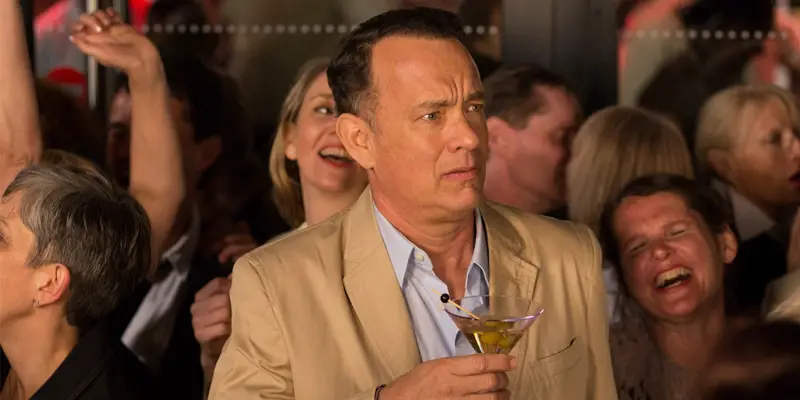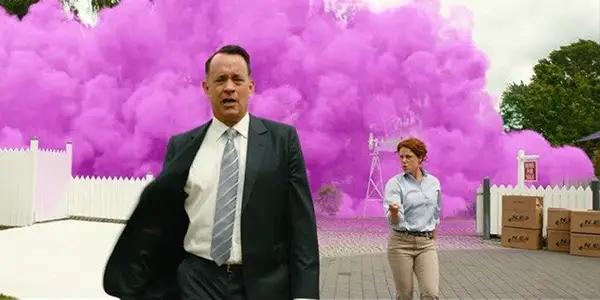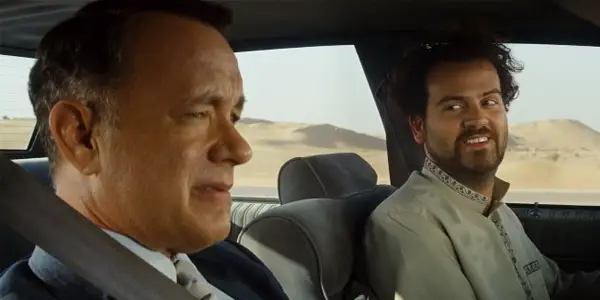A HOLOGRAM FOR THE KING: A Rambling Mess of a Film

Alex is a 28 year-old West Australian who has a…
Is there a term for one-hit wonder film directors? Whilst the idea of the one-hit wonder is quite prevalent within music (I’m a sucker for late ’90s, early 2000s one hit wonders, who doesn’t love Breakfast at Tiffany’s?), it’s a concept that’s becoming quite frequent in cinema as well; filmmakers who coast off the success of one film.
Neil Blomkamp burst onto the scene with District 9, a refreshing mix of sci-fi and action that became a huge mainstream hit, but has since followed it up with two subpar derivatives of his first film, with Elyisum and Chappie. Daniel Myrick and Eduardo Sanchez changed the face of mainstream horror and viral marketing with The Blair Witch Project back in 1999, but have failed to make anything of note since.
It seems that Tom Tykwer’s new film, A Hologram for the King, adds him to the list of one-hit wonder directors, with his big film being the underground hit Run Lola Run back in 1998. A Hologram for the King features Tykwer’s known style of repetition and alternative music choices, and is a sad misfire.
The Problem with Book-to-Film Translations
A Hologram for the King is based upon Dave Eggers’ 2012 book of the same name, and boy does it feel that way. It is unfair to say that book-to-film adaptations do not work, but they are difficult to pull off successfully for a number of reasons.
The advantages of book-to-film adaptations include the ability to visual interpret the original narrative, bringing a fresh perspective on much-loved material. It also allows filmmakers to fix elements of the story that perhaps could’ve used reforming (famous examples of this are the adaptations of Fight Club and The Shining).
The big problem lies with the clashing narrative lengths of the two mediums, with books usually going on for hundreds of pages, an unrestricted stream of information that can be started and stopped at any point.

Films are quite stilted when it comes to this, with a script usually being limited to under 150 pages and the films themselves at under 2 hours, which means heavy exposition, character nuance and intricate narratives must be cut down significantly to adhere to cinematic methods.
This accounts for many unsuccessful book adaptations, which try to shove in epic-length stories into minuscule run-times, resulting in rushed storytelling and unsatisfied audiences who always expect a faithful recreation of their favourite books, even though it rarely ever happens in Hollywood.
A Hologram For the King is sadly one of those unsuccessful adaptations, a film which doesn’t work due to its original source material. The always dependable Tom Hanks stars as Alan Clay, an ageing IT salesman who feels like he’s at the end of his rope – a messy divorce with his wife has left him with no money, no home and desperate for money to fund his daughter’s college fund. This situation forces him to take a frightful job aspect from his company: go to Saudi Arabi to try and sell the King a 3D holographic calling system for his upcoming city infrastructure.
In a typical fish-out-of-water fashion, the stiff businessman Clay finds himself at odds with the contrasting Saudi Arabian atmosphere, clashing against the cultural differences and the increasingly difficult business-related problems.
Along the way he becomes friends with an eccentric taxi driver who has a love for ’80s music, Yousef (Alexander Black) and Zahra (Sarita Choudhury), a female doctor that Clay starts to develop romantic feelings for.
The Lack of Payoffs
To address the main problems with A Hologram For The King, you must understand the idea of narrative sets up and payoffs, and how great movies have the ability to introduce various plot strands that intersect in creative and cohesive fashions.
Most films follow the basic function of equilibrium (normality), disequilibrium (something’s different), and new equilibrium (new normality), a standard three-act structure that can be applied for most genres: romantic comedies (boy meets girl), horror (boy meets monster), and action (boy meets conflicting element).
When movies attempt to mess with this linear type of storytelling, like most experiments, it can be a wild success or a complete mess, depending on the craft of the filmmaker(s) behind the material. During this three-act structure, a film is usually filled with various subplots, which can perform several functions: propel the main narrative further, explore character functionality, introduce thematic content, or feature pure entertainment that keeps the film enjoyable.
Great films marry the subplots and main narrative successfully, making sure that not a scene is wasted and that these subplots are organically driven by the story, not on separate tracks, as this can give a film a feeling of being detracted, meandering or overlong.

The Coen Brothers are terrific at interweaving their various subplots in a cohesive fashion, with a prime example being their work in Fargo. In Fargo, we are introduced to various characters, settings and arbitrary scenes which all come together by the film’s ending, loose strands which all contribute towards a mutli-layered, intelligent type of filmmaking that few filmmakers can capture.
To see an example of bad subplot integration, an easy example (one that most people have seen) is Tommy Wisceau’s The Room, where we laugh at how pointless and random the characters and scenes are. Whilst these two films are at extreme polar opposites, they highlight the importance of understanding the building of narrative, something which A Hologram for the King simply doesn’t, and it’s the film’s biggest detriment.
The film crams in so many subplots within its 95-minute running time that it becomes quite ridiculous, to the point where it sometimes feels like you’re watching a “Previously On” catch-up montage of a decent Tom Hanks TV series.
The main narrative drive of the film is Tom Hanks attempting to accomplish his business deal with the King of Saudi Arabia in order to redeem himself personally and financially. That’s a fine setup for a film, but due to it trying to be so faithful to its novel origins, Tywker tries to cram all the various subplots that were probably better elaborated on within Dave Eggers’ popular book.
The film gets frequently distracted with each new character it introduces, and it simply forgets about the last one it introduced, like a speed dater with ADD.
The Actors Save the Day
Yousef, Clay’s guide in Saudi Arabi, is a character who is brought in fairly early into the film as the comic relief and exposition machine, alongside a subplot about how he’s scared of being assassinated by the husband of a woman that he’s in love with.
Once again, a decent setup for the beginning of a film – it introduces intrigue and a level of suspense that could have been used quite creatively throughout the story. Alas no, as apart from some off-hand references and a mild mention near the end, the film completely forgets about this subplot and carries on, despite a pretty insistent and alarming establishment of it initially.
This type of lackadaisical plot development happens constantly throughout A Hologram for the King, to the point that you think it is going to become like Richard Linklater’s Slacker and completely forget about Tom Hanks, and just follow another pointless character that the film wants to bring in.
Despite the actors clearly trying their best and some nice cinematography, it all feels wasted when they service an in-cohesive film that clearly needed some editing and script-rewrites before hitting the screen.
The erratic editing style borrows heavily from John Boorman’s brilliant crime film Point Blank, an American film which introduced the repeated use of flashbacks and character moments to reflect the current state of mind of the protagonist in each scene.
Through these brief insights of Alan Clay’s memories, the film is able to piece together some form of backstory of the fractured businessman, an incredibly predictable history that has been seen countless times throughout all forms of media: the man with a mid-life crisis.
The element that this film doesn’t get right is that the repetition within Point Blank speaks towards that film’s intended dream-like atmosphere; the recurring cutaways jar the viewer and reinterpret past events for significant narrative intentions.
A Hologram for a King just throws in cutaways to different elements of Alan Clay’s past and current mental state, but they are give superficial bouts of exposition, without actually saying anything. Exploring his complicated relationship with his daughter is limited to several fabricated interactions, another character who the film forgets about come the midway point.

It may sound like I’m harping on one point of A Hologram for the King, but sadly there really isn’t much to talk about outside of the film’s confused delivery. Tom Hanks is great, delivering a central performance that’s just as good as all of his previous works, even if the material itself doesn’t seem as challenging for the experienced actor. Hanks saves the film, giving it a breath of sophistication and charm that is lacking in its bland dialogue and character interactions.
The other stand-out role of the film is newcomer Alexander Black (this is his first feature film), the goofy taxi driver who works well with the straight-laced Hanks, and gives life to the story in its second half when it surely needs it. If A Hologram for the King can do something right, it’ll allow Black’s performance to be seen by a different director and picked for a much better and rewarding role.
Genre legend Tom Skerritt is wasted in a three-second scene, as he joins the parade of useless side characters, alongside a bafflingly needless cameo from Ben Wishaw, who shows up in hologram form for reasons that I cannot fathom why.
The Verdict
Unfortunately A Hologram For the King is a muddled, confused film that ranks as one of Tom Hanks’ lesser works, reflected in the film’s extremely poor box office return (it is his lowest grossing film since 1986).
Despite Hanks’ best efforts in the central role, he’s stuck in a series of middling subplots and diversions that never amount to anything, a confusing mess of political comedy and superficial metaphors, bogged down by Tom Tykwer’s insistence on sticking to the source material’s original complicated narrative.
I’m sure there is a collection of deleted scenes that really flesh out the supporting cast, all who are wasted as the film constantly forgets their role, as it barrels on to introduce a new unnecessary addition to the snowballing story.
Many critics seem to note the opening scene being A Hologram for the King’s best highlight, a bizarre sequence where Tom Hanks configures the lyrics to the famous Talking Heads song “Once In a Lifetime” to suit his character’s dire situation, an illustrated scene that immediately alerts the audience to attention and makes you think the upcoming film might contain this frenzy of originality and energy. That is, until the rug is pulled out from under you and the film starts its series of false beginnings and narcoleptic plot machinations.
The best way to describe A Hologram for the King is like a clickbait article – a flashy banner to get your attention (Tom Hanks, a song we all like) only to pull you into a myriad of pointless content, but by that time it’s too late – your time, money and attention have already been pawned to another being, never to be returned.
What are some of your favourite Tom Hanks films?
Does content like this matter to you?
Become a Member and support film journalism. Unlock access to all of Film Inquiry`s great articles. Join a community of like-minded readers who are passionate about cinema - get access to our private members Network, give back to independent filmmakers, and more.













